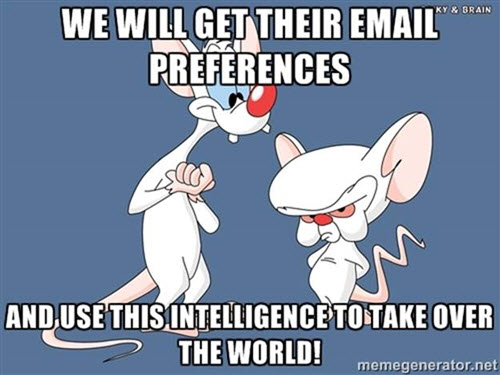Email Marketing: Genuine mistake or evil genius email tactic?
Just the other day, I received an interesting email from a company that shall not be named (we’ll call them “the Brain” for the purposes of this post).
This email read, “Thank you for your interest in our 2013 Canadian Bacon Report.” I was invited to access my copy of the report, download my free copy of the presentation and attend a related webinar.
The thing is, while I am a subscriber of the Brain’s list, I was not at all interested in the report, nor did I ever indicate that I was ever interested (no offense to Canada).
I sat puzzled for a second and then just proceeded to delete and move on with my inbox purging.
Later that night, a little email notification popped up on my phone that stated, “Yeah, We Messed Up. Our Apologies … ” It was from the Brain.
This conversational and customer service email informed me that they had a “technology glitch” and accidentally sent me the report.
“But don’t get us wrong,” the email stated, “This is a great report, as are all 18 of our global reports on bacon.”
Not-so-shameless plug.
They apologized for sending me something that may not have been of my interests.
Post apology, the Brain seized the opportunity to ask me to update my email preferences to make sure they were sending me email communications based on my preferred topics: “It will be less than 30 seconds, we promise.”
Genuine mistake or evil genius email tactic?
I wasn’t sure until curiosity got the best of me, and I decided to “update” my email preferences.
My conclusion: evil genius.
After I “updated my preferences” with information that was never asked of me when I signed up for the Brain’s list, I received a third email.
This email stated it all: “Subscription Confirmation: Thank you for joining the Brain’s mailing list.”
Update, not so much; list subscription ploy was more like it. I wasn’t sure whether I should be offended or impressed.
Whether this was truly a mistake or a calculated psychology tactic, it probably worked well for them for a couple of reasons.
It took a customer-serving approach to something that typically seems more company-serving:
- Updating your email preferences – aka telling the marketer what subjects are most interesting to you so they can market to you better.
- Instead of a generic “please update your preferences for our benefit,” it was a, “So sorry, please help us. Going forward, we want to make sure we’re sending you things you are interested in.”
It also puts the reader in the right psychological mindset to want to update their preferences.
I received something that I was not interested in, so yes, I will tell you what I am interested in so this doesn’t happen again.
So what do you think? Mistake or evil genius?
You may also like
Email Summit 2014: Finding your email voice [More from the blogs]
Email Marketing: What I’ve learned from writing almost 1,000 emails for MarketingSherpa [More from the blogs]
Email Copywriting: How one company generated a 400% increase in CTR [Video]
Categories: Email Marketing Email Marketing, email preferences, list building, marketing strategy, marketing tactics











The third email is alarming, imho. Joining the email list? This sounds as if they’re not sure about their opt-in policies and lists. They thought out this ‘send a report email’ process with an oopise attached, with request to update. Going from update prefs to actual subscribe is the biggest thing here, imho: it’s misleading and strange, regardless of how you preceived the email communications.
If this was indeed done on purpose, I hope for the ‘Brain’ company it won’t backfire in terms of unsubscribes and spam reports. In that case, this evil genius plan doesn’t seem so genius anymore.
Knowing a bit about the pressure email marketers are under to increase conversions, downloads, etc… I’ll go out on a limb and say it was a third option “outright spam.” Except they probably assumed it wasn’t because you were already subscribed.
Mass email blasts like this however inevitably lead to a backlash which is probably why they sent a follow up apology email.
At least they tried to correct their bad behavior instead of denying or doubling down!
Possibly both! If they truly did goof up, what a great recovery.
If it’s purely evil genius…well, it worked, didn’t it?
“Marketing by Pinky and the Brain” is something I would really like to see, actually! Imagine the possibilities.
I vote for pure evil genius. The sequence of events that unfolded were too obvious to have been accidental, or “Gee we’re sorry.” People are trying all the time to figure a way to make their email marketing more effective, and all too many people with that responsibility/challenge may be inclined at times to deceive just a little.
Hmmm…It’s so tempting to assign evil motives. Perhaps the final “Subscription Confirmation” email was simply an oversight to an otherwise creative response to a genuine blooper? After all, technology glitches do happen. What if the Brain’s assistant forgot (or didn’t think) to create a new confirmation response and used the generic auto email for regular opt-in subscribers?
They are clearly evil genius!
They can create different segments: one interested in that report and the others with the updated information.
Thanks everyone for all the comments! Some really great thoughts here… I think the additional possibilities are very interesting and quite possible: complete oversight, outright spam, true mistake followed by evil genius. Keep ’em coming!